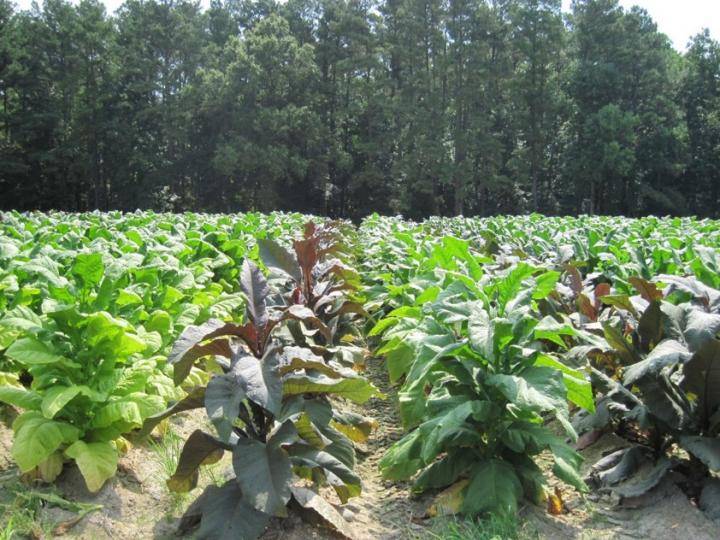“A number of techniques can be used to successfully reduce specific chemical compounds, or alkaloids, in plants such as tobacco, but research has shown that some of these techniques can increase other harmful chemical compounds while reducing the target compound,” said De-Yu Xie, professor of plant and microbial biology at NC State and the corresponding author of a paper describing the research. “Our technology reduced a number of harmful compounds – including the addictive nicotine, the carcinogenic N-nitrosonornicotine (NNN), and other tobacco-specific nitrosamines (TSNAs) – simultaneously without detrimental effects to the plant.”
The technique uses transcription factors and regulatory elements as molecular tools for new regulation designs. Regulatory elements are short, non-coding DNA fragments that control the transcription of nearby coding genes. Transcription factors are proteins that help turn certain genes on or off by binding to regulatory elements. Xie hypothesized that these could be useful molecular tools to design new regulations for engineering new plant traits. Two Arabidopsis transcription factors in particular, PAP1 and TT8, are known to regulate the biosynthesis of anthocyanins, or classes of nutraceutical compounds with antioxidant properties. Xie further hypothesized that these proteins could be used as molecular tools to help repress a number of harmful chemical compound levels, such as nicotine.
“PAP1 regulates pigmentation, so tobacco plants with our overexpressed PAP1 genes are red,” Xie said. “We screened plant DNAs and found that tobacco has PAP1- and TT8-favored regulatory elements near JAZ genes, which repress nicotine biosynthesis. We then proposed that these elements were appropriate tools for a test. In all, we found four JAZ genes activated in red tobacco plants with a designed PAP1 and TT8 cassette overexpressed.”
Xie and his colleagues tested the hypothesis by examining tobacco plants in the greenhouse and in the field and showed the reductions of harmful chemical compounds and nicotine in both types of experiments. NNN levels were reduced from 63 to 79% in leaves from tobacco plants that had PAP1 and TT8 overexpressed, for example. Overall, four carcinogenic TSNAs were significantly reduced by the technique.
Xie believes that the technique holds the potential to be used in other crop plants to promote other beneficial traits and make some foods healthier.
The paper appears in Journal of Advanced Research. Research associate Mingzhu Li is a first author of the paper. Former postdoctoral fellows Xianzhi He and Christophe La Hovary are co-first authors. The research was supported by the R.J. Reynolds Tobacco Co.
“A De Novo regulation design shows an effectiveness in altering plant secondary metabolism”
Authors: Mingzhuo Li, Xianzhi He, Christophe La Hovary, Yue Zhu, Yilun Dong, Shibiao Liu, Hucheng Xing, Yajun Liu, Yucheng Jie, Dongming Ma, Seyit Yuzuak and De-Yu Xie, NC State University
Published: June 20, 2021 in Journal of Advanced Research
DOI: 10.1016/j.jare.2021.06.017
Abstract:
Introduction
Transcription factors (TFs) and cis-regulatory elements (CREs) control gene transcripts involved in various biological processes. We hypothesize that TFs and CREs can be effective molecular tools for De Novo regulation designs to engineer plants.
Objectives
We selected two Arabidopsis TF types and two tobacco CRE types to design a De Novo regulation and evaluated its effectiveness in plant engineering.
Methods
G-box and MYB recognition elements (MREs) were identified in four Nicotiana tabacum JAZs (NtJAZs) promoters. MRE-like and G-box like elements were identified in one nicotine pathway gene promoter. TF screening led to select Arabidopsis Production of Anthocyanin Pigment 1 (PAP1/MYB) and Transparent Testa 8 (TT8/bHLH). Two NtJAZ and two nicotine pathway gene promoters were cloned from commercial Narrow Leaf Madole (NL) and KY171 (KY) tobacco cultivars. Electrophoretic mobility shift assay (EMSA), cross-linked chromatin immunoprecipitation (ChIP), and dual luciferase assays were performed to test the promoter binding and activation by PAP1 (P), TT8 (T), PAP1/TT8 together, and the PAP1/TT8/Transparent Testa Glabra 1 (TTG1) complex. A DNA cassette was designed and then synthesized for stacking and expressing PAP1 and TT8 together. Three years of field trials were performed by following industrial and GMO protocols. Gene expression and metabolic profiling were completed to characterize plant secondary metabolism.
Results
PAP1, TT8, PAP1/TT8, and the PAP1/TT8/TTG1 complex bound to and activated NtJAZ promoters but did not bind to nicotine pathway gene promoters. The engineered red P+T plants significantly upregulated four NtJAZs but downregulated the tobacco alkaloid biosynthesis. Field trials showed significant reduction of five tobacco alkaloids and four carcinogenic tobacco specific nitrosamines in most or all cured leaves of engineered P+T and PAP1 genotypes.
Conclusion
G-boxes, MREs, and two TF types are appropriate molecular tools for a De Novo regulation design to create a novel distant-pathway cross regulation for altering plant secondary metabolism.


